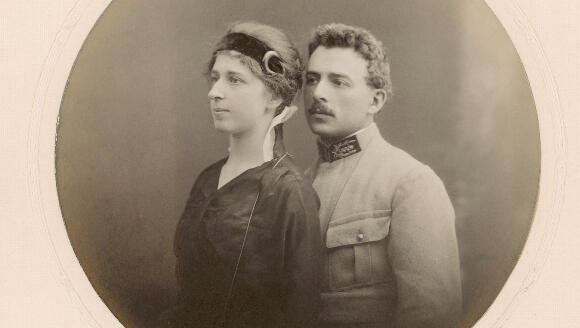In 1965, the Nobel Prize in Medicine was awarded to three French scientists for their groundbreaking discoveries in bacterial genetics. Among them was André Lwoff, who was recognized for his discoveries on how certain viruses attack bacteria, a breakthrough discovery of great importance for both research and medicine. Lwoff's work continued in the footsteps of his mentors at the Pasteur Institute in Paris, Élisabeth and Eugène Wollman. Had history unfolded differently, it is conceivable that the Wollmans might have stood with him on the Nobel stage in Stockholm, to share in the honor of this prestigious award.
From Minsk to Paris
Eugène Wollman was born in 1883 in Minsk, then part of the Russian Empire and now in Belarus. His father, Mordechai, was a doctor, and his mother, Sonia, was a mathematician. During his childhood, the family moved to the United States and settled in New York, but they struggled to establish themselves economically. The father barely made a living from medical work in poor neighborhoods, and after a few years, he died of a disease, likely contracted from one of his patients. Sonia, left alone in a foreign country with two young children, packed up Eugène and his sister Sophia and returned with them to Minsk, where she managed to make a living teaching mathematics. Eugène was an excellent student, and after finishing high school, his mother – like many educated families in Russia at the time, deeply immersed in French culture – decided to send him to study engineering at the University of Liège in Belgium.
Eugène was not satisfied with this alone: after graduating in engineering, he decided to follow his father's legacy, and in 1909 completed his medical studies. He was more drawn to research than to clinical medicine, and in the last three years of his studies worked as a research assistant to the Belgian zoologist Edouard Van Beneden, known for discovering meiosis – the cell division process in which egg and sperm cells are formed. After his studies, he received a scholarship to further his training at the Pasteur Institute in Paris, which was one of the leading centers in the world for biological research.
Élisabeth Michelis was also born in Minsk in 1888, one of four children of an educated Jewish family from the middle class. Her father was a businessman who dabbled in various fields, from insurance to manufacturing dentures. She was an excellent student, and her parents decided to send her to Liège, where she wanted to study physics. Her mother, who heard from her acquaintance Sonia Wollman that her son was also studying in Liège, provided Élisabeth with his contact details, and the two met there. "From her letters from that period, it is clear that she had many suitors, and one of them was Eugène.
7 View gallery
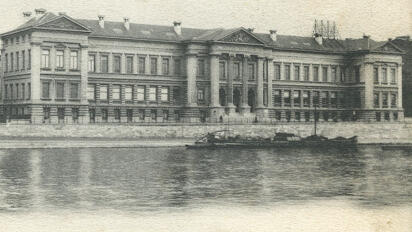

The Institute of Zoology building at the University of Liège, where Eugène Wollman began his research career as a medical student
(Photo: University of Liège)
After he moved to Paris and she was still studying in Belgium, he pleaded with her to join him there, obviously intending to marry her. Eventually, she agreed," their grandson, Prof. Francis-André Wollman, told the Davidson Institute website in an interview. "Both families were not religious, but were immersed in the Jewish community, and the two were married in 1910 in a Jewish wedding, probably in Germany."
Researcher and Volunteer
Eugène Wollman began working at the Pasteur Institute, in the laboratory of Élie (Ilya) Metchnikoff, a renowned Russian scientist. In 1908, Metchnikoff was awarded the Nobel Prize in Physiology or Medicine (jointly with Paul Ehrlich) for his groundbreaking research in immunology, particularly for discovery of phagocytosis, the process by which certain cells of the immune system engulf foreign agents such as bacteria or cells infected by foreign invaders.
Wollman worked with Metchnikoff on studies of bacteria that decompose starch in animal intestines, as well as on developing methods for growing laboratory animals in sterile, bacteria-free conditions for research. Later, he also studied how certain bacteria produce vitamins of the A and B groups. Their professional collaboration deepened into a very close personal friendship. "The Metchnikoffs, being much older, viewed my grandparents almost as their adopted children," Francis-André Wollman recounted. "The families would spend weekends together, and my father, born in 1917, a year after Metchnikoff’s death, was named after him – Elie Wollman."
When World War I broke out, Eugène Wollman volunteered to serve in the army as a combat medic, despite having limited experience in clinical medicine. Metchnikoff opposed the idea, believing it would be preferable for Eugène to volunteer for a military research laboratory. However, Wollman, who did not yet have French citizenship, believed such service would improve his status. He initially served in a hospital in Paris, and was later sent with field units to Africa and the Middle East. His service during the war apparently facilitated the granting of French citizenship to him and his family in 1922. "It is interesting to see that when he corresponded with Élisabeth while she was still in Liège, their letters were in Russian, and a few years later, during the war, he wrote to her in French. He was fluent in several languages, and his French was excellent," their grandson noted. "He was also a man of principle, and wrote to her about an incident at an officers' club in Senegal where he intervened when two civilians were racially disparaging a black officer seated nearby."
After the war, Wollman was appointed as a researcher at the Pasteur Institute, and continued working on research related to the health of farm animals. At that time, one of the central focuses of scientific research and interest was bacteriophages – biological agents that target and eliminate bacteria. Despite the discovery of bactericidal properties towards the end of the 19th century, the precise nature of these bacteria-killing agents remained elusive in the early decades of the 20th century and this question occupied many microbiologists. Today we know that bacteriophages are viruses that infect and kill bacteria.
Élisabeth Wollman, who joined her husband in Paris in 1910, continued her studies at the Sorbonne University and further specialized in physical chemistry. Despite her desire to conduct research at the Pasteur Institute, societal norms hindered her employment opportunities since she was a woman, and also the wife of a researcher who already provided for the family. No one saw fit to employ her in a regular position, similar to a man. Instead, she was allowed to work voluntarily in the laboratory of chemist Jacques Duclaux, whose research focused on colloids – mixtures of different materials that do not fully mix, such as suspensions.
7 View gallery
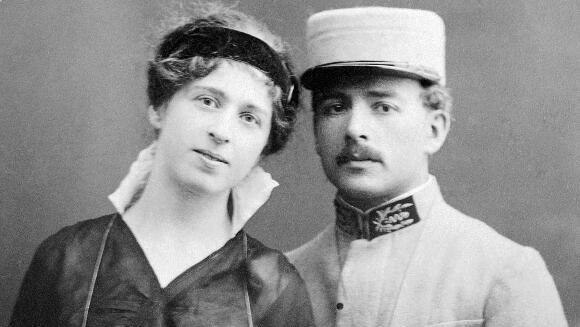

Eugène in army uniform together with Élisabeth
(Photo: Institut Pasteur/Musée Pasteur)
At the same time, she was involved in the work in her husband's laboratory. In 1912 she published a joint article with Metchnikoff himself on sterilization methods, and in 1915 the couple Wollman published their first joint article, within the framework of Eugène's work on the sterile breeding of animals and their consumption of bacteria found in barnacle food. It was also during this period, that their three children – Alice, Elie, and Nadine – were born.
Fruitful Collaboration
In 1920 Élisabeth Wollman concluded her work with Duclaux, and transitioned to work alongside her husband, still in a voluntary capacity without pay. Their grandson is uncertain about the precise reasons for this move. It appears likely that both Eugène and Élisabeth had desired this arrangement for some time, and circumstances eventually aligned to facilitate the change. Over the next two decades, they collaborated closely together, publishing many joint articles, although both of them also published separately. "I'm not entirely sure how they divided their tasks," their grandson remarked, "But one thing is certain – she wasn't merely a technician or assistant in his laboratory; she was a full partner in their work." He further noted, "However, it is also evident that he primarily worked in the lab, while she balanced her research responsibilities with caring for the household and their children."
"Everyone in Eugène Wollman's laboratory recognized the important role she played there," cited researchers Jean Gayon and Richard Burian, quoting Pierre Mercier in an article about the Wollman couple and their contributions. "She not only conducted experiments and meticulously analyzed their results but was also involved in experiment planning, raising scientific hypotheses, and skillfully guided her husband's sometimes fiery approach towards constructive compromises."
As mentioned, their work focused on bacteriophages, and more specifically the phenomenon of lysogeny – the destruction or degradation of bacteria. Initially, in the 1920s, the Wollmans postulated that lysogeny resulted from a hereditary factor passed from bacterial cells to their offspring, potentially spreading to other bacteria via the culture medium. However, through years of experimentation, their perspective evolved. They demonstrated, among other findings, that bacteriophage particles exceeded the size of known cell components. Concurrent with advances in virology and the recognition of viruses as distinct life forms from bacteria, they were among the first to suggest that lysogeny might result from a viral attack on bacteria, a notion considered revolutionary at the time.
In 1929, the Wollman couple took a break from their ongoing research, and embarked on a three-year mission to Chile. "Germany then established a biological research institute in Chile, and as part of the scientific rivalry between Germany and France, the latter decided to follow suit. The Pasteur Institute established a 'health institute' in Santiago, and Eugène Wollman was invited to oversee its early years," recounted their grandson. "Certainly, economic factors influenced the decision as well. Living conditions in Chile were superior to those in France, where scientists did not enjoy particularly high salaries. This mission enabled them to purchase an apartment in Paris upon their return."
7 View gallery
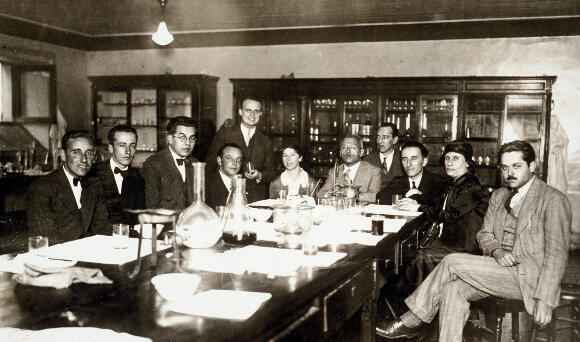

Did not have enough time to implement the groundbreaking method they developed. The Wollman couple (in the center) with their colleagues at the Health Research Institute in Santiago, Chile
(Photo: Institut Pasteur/Musée Pasteur)
After their return from Chile in 1932, the couple resumed their collaborative work, which remained as fruitful as ever. During the 1930s they authored no less than 18 joint articles, alongside additional works, predominantly focusing on bacteriophages. "Among other things, their research delved into methods for purifying cultures from such agents, and with the aid of modern microscopy, they developed a technique for isolating individual bacteria in order to start new cultures," recounted their grandson. This approach held promise for uncovering bacteriophages as parasites existing within bacterial cells, although they did not ultimately realize this potential.
Together Until the End
In 1940, as Germany conquered France, Eugène and Élisabeth Wollman, then aged 57 and 53 respectively, were established scientists and prominent figures at the Pasteur Institute. In the framework of their work they also mentored research students, and one of these was André Lwoff, a Jewish microbiologist, who also worked alongside his wife at the institute. "My grandparents adopted the couple Lwoff much as the Metchnikoffs had embraced them in their youth," recounted Francis-André Wollman, whose middle name was given to him after Lwoff.
Their eldest daughter, Alice, was already a medical doctor working in Tunisia. Their son Elie was nearing the completion of his medical studies, and their youngest daughter, Nadine, had just been accepted to study physics at a prestigious institute.
As Nazi forces entered Paris, many French institutions, including most Pasteur Institute staff, relocated south. However, when the institute’s head sought volunteers to stay behind to prevent the Nazis from commandeering or destroying the institute, Eugène, who was Jewish, volunteered, citing his fluency in German as useful, despite the huge personal risk. "His argument was that he spoke German. He sent his wife and their young daughter south, and stayed behind alone," the grandson recounted. "In the diary he wrote in those days, he recounts that the German officers wanted to establish their own laboratories at the Pasteur Institute, but he identified vacant buildings elsewhere in advance, managed to convince them that these would better suit their laboratory needs, and even drove there with them in order to show them the property. Thus, he managed to save the institute."
A few weeks later, many Parisians who had fled south began gradually returning to now-occupied Paris, in an attempt to continue their lives, including Élisabeth and Nadine Wollman. Élisabeth returned to her work at the institute, and Nadine began her physics studies. Elie, on the other hand, decided to complete his medical studies in Lyon, in southern France, where he was accepted for an internship with a professor who was a French nationalist and anti-Semite. However, despite his prejudices, his hatred for the German occupiers was even greater, and he helped Elie Wollman to join the French resistance efforts against the Nazis. Later, the professor was captured and executed.
For about two years, the couple Wollman managed to maintain a work routine and a semblance of normalcy at the Pasteur Institute under the German occupation. They continued their research, but could no longer publish their work under their own names due to racial laws, and thus allowed others to publish their findings. In July 1943, Elie managed to arrive in Paris under a false identity, in order to attend his sister’s wedding to one of her fellow students. This was the last time he saw his parents.
7 View gallery
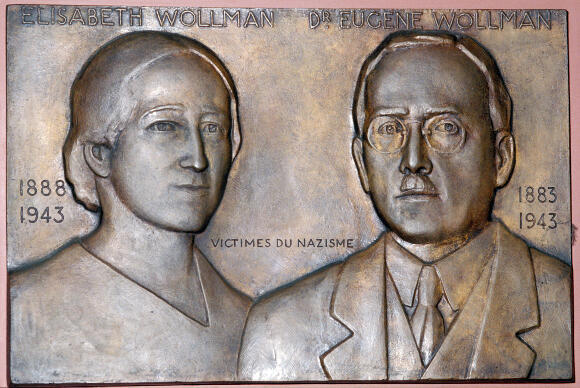

"Victims of Nazism". A memorial plaque in memory of Eugène and Élisabeth Wollman, designed by artist Marcel Renard, at the Pasteur Institute
(Photo: Institut Pasteur/Musée Pasteur)
In March 1943, the French police came to the Pasteur Institute to arrest Eugène Wollman. The head of the institute managed to conceal him in the institute's hospital and explained to the police that he was hospitalized. Since then, Wollman stayed in the hospital all day, and only occasionally, on weekends, spent time with his wife in their apartment. By December that year, the arrests resumed. The police raided their apartment, where Élisabeth was staying together with Nadine and her husband. The husband – who was not Jewish – was released. The mother and daughter were taken into custody at the women's prison in Paris.
Nadine and her husband also worked together, alongside Frédéric Joliot, a physicist married to the daughter of Pierre and Marie Curie. Joliot-Curie, a Nobel laureate in Physics alongside his wife Irène, was active in the French resistance and managed the Radium Institute during the war, which had been established by his mother-in-law. He managed to maintain good working relations with the Germans. Due to his connections and thanks to her marriage, Nadine was released from custody. She was reluctant to part with her mother, but Élisabeth asked her to try to contact Eugène. Nadine made her way to the Pasteur Institut, and managed to witness her father’s arrest as he was placed into an ambulance, supposedly still hospitalized.
Eugène and Élisabeth were both taken to the Drancy internment camp, near Paris, and from there their whereabouts were unknown. For years, the fate of the Wollman couple remained uncertain until it was revealed that they were transported by train to Auschwitz, where they were likely killed in the gas chambers immediately upon arrival. According to the documentation obtained by the family, both were on train number 63, which left Drancy on December 17, and were murdered on December 22. They probably reunited in the camp and made their last journey together, but out of approximately 900 people who were crammed into the wagons, less than 25 survived. None of them knew Eugène and Élisabeth Wollman.
7 View gallery
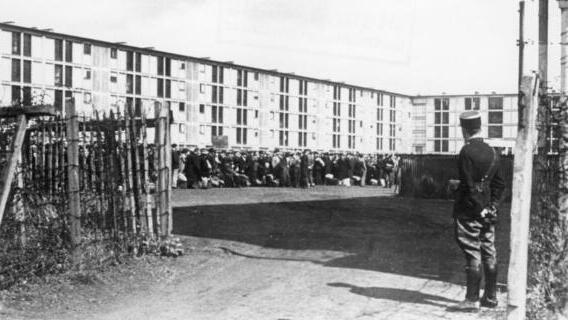

Arrested separately, likely reunited in the internment camp, before meeting their tragic fate in the gas chambers. Drancy internment camp, suburban Paris, 1941
(Photo: Bundesarchiv, Bild 183-B10919, Wikipedia)
A Distinguished Lineage
The reasons behind the arrest of Eugène and Élisabeth Wollman remain unclear. Unlike in other countries, the Nazis did not implement a blanket policy to exterminate all Jews in France, but the local police was required by the Nazis to provite a quota of Jews to be arredted and transported. The Wollmans continued their work at the institute under German awareness for more than three years. The fact that it was the French police, rather than the Gestapo or another German security service, who carried out the arrests suggests that the reason for their detention was not some alleged anti-Nazi action, but related to slander or a false accusation. "There were anti-Semites and collaborators at the Pasteur Institute as well, but we have not been able to discover who might have betrayed them," their grandson explained.
Upon learning of his parents' arrest, Elie Wollman returned to Paris under a false identity, hoping to gather information about their fate and to work towards their release. While staying at the home of a Jewish friend from his university days, which served the resistance as a hiding place for British pilots who had parachuted into France, he shared his plans to about his intention to enlist as a doctor in one of the "Maquis" units fighting the Germans in the mountains and rural areas. However, he was warned by one of those present that the Germans were planning an imminent attack on that particular unit, prompting him to join another. This advice proved lifesaving, as the unit that Wollman did not join was destroyed in a German attack.
"After the liberation of Paris, my father came to the police headquarters armed with a gun, intending to kill the police officer who had arrested his parents. The officer was not there, and ultimately my father settled for filing a lawsuit against him," Francis-André Wollman recounted. "At the trial, Jews testified that the officer had, in fact, helped them and even saved their lives. He was acquitted, and went on with his life."
7 View gallery
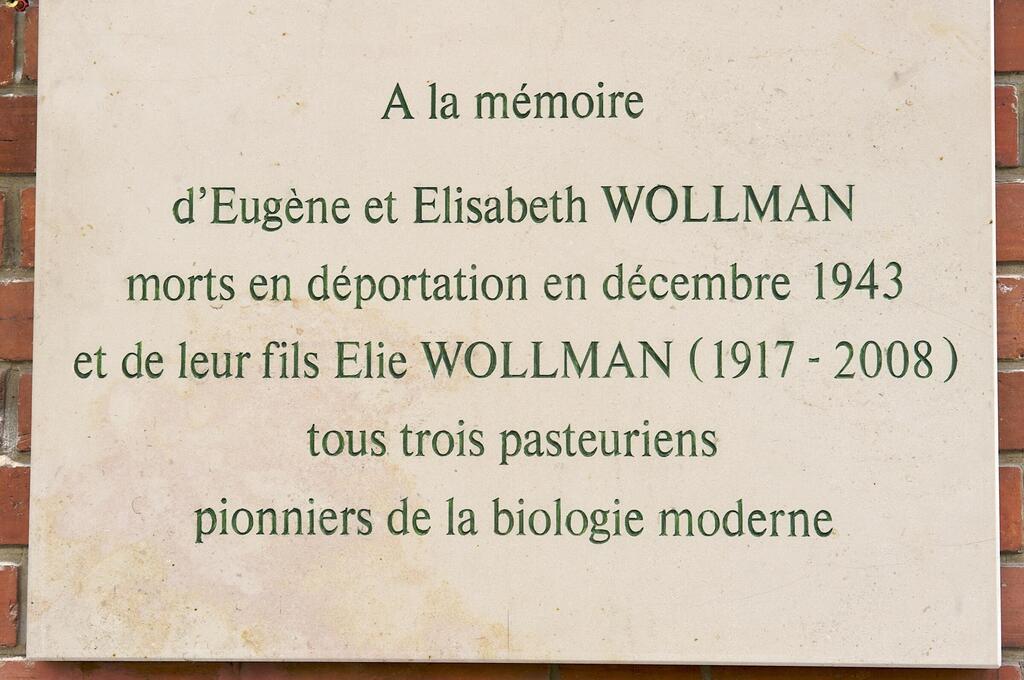

Three Pioneers of Modern Biology," a memorial plaque at the Pasteur Institute in Paris, commemorating Eugène and Élisabeth Wollman, and their son, Élie Wollman
(Photo: Institut Pasteur - photo François Gardy)
Ultimately, Elie Wollman carried on with his life, joining André Lwoff at the Pasteur Institute, where he continued his parents' work. Among his achievements, he employed their method to cultivate cultures from a single bacterium, confirmed bacteriophages as viruses, and elucidated the mechanism by which they infect bacteria. In 1965, he was awarded the Nobel Prize in Physiology or Medicine, alongside two other French researchers, François Jacob and Jacques Monod.
In his Nobel lecture, Lwoff repeatedly acknowledged the significant work of the Wollman couple and their contributions to the field. "I don't know if my grandparents would have received the Nobel Prize had they not been killed in Auschwitz, and it's inconsequential," remarked Francis-André Wollman. "They were on their way to discovery, but that does not detract from the importance of Lwoff's work, who was a brilliant scientist and deserved to be awarded the prize, without partners, and earlier."
Elie Wollman went on to have a remarkable scientific career, leading pioneering research in bacterial genetics at the Pasteur Institute, which, among other things, laid the groundwork for the research that earned François Jacob the Nobel Prize. He passed away in 2008. His son, Francis-André Wollman, born in 1953, is a renowned biologist researching the molecular mechanisms of photosynthesis and a Research Director at the French National Centre for Scientific Research (CNRS). Many other grandchildren and great-grandchildren of Elisabeth and Eugène Wollman have followed in their footsteps, pursuing careers in science and medicine. The Nazis may have succeeded in killing them, but not their path of their legacy.


